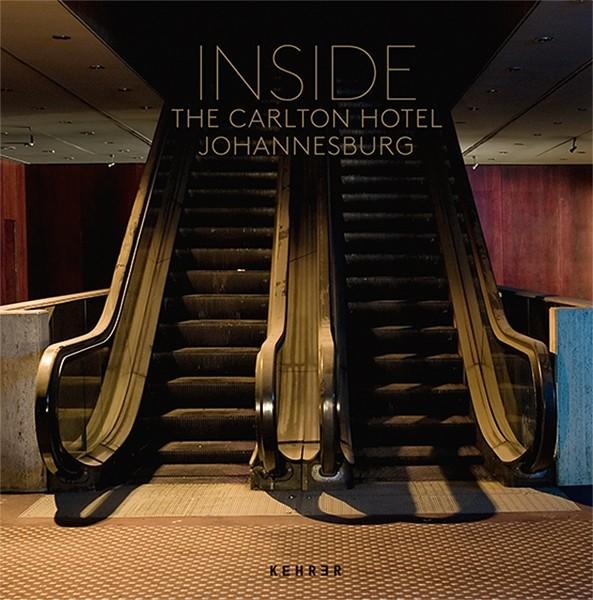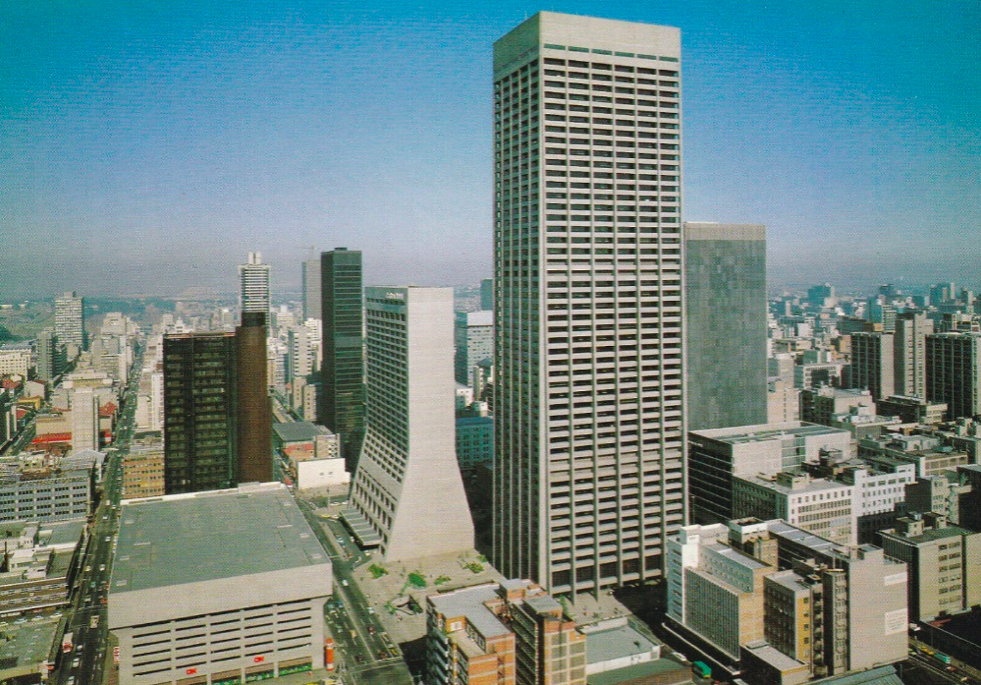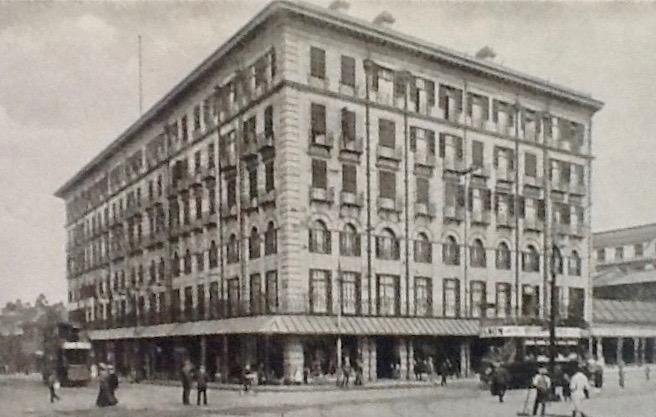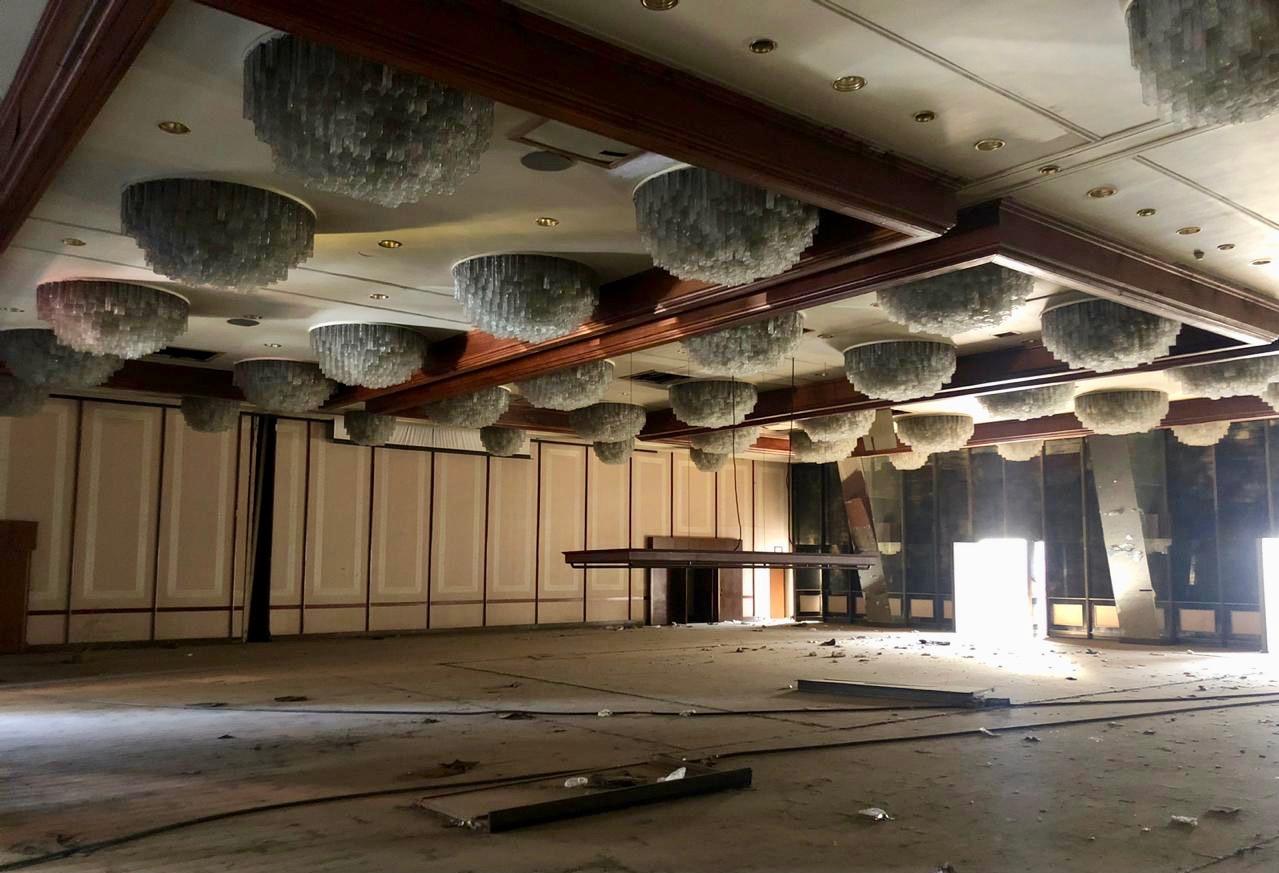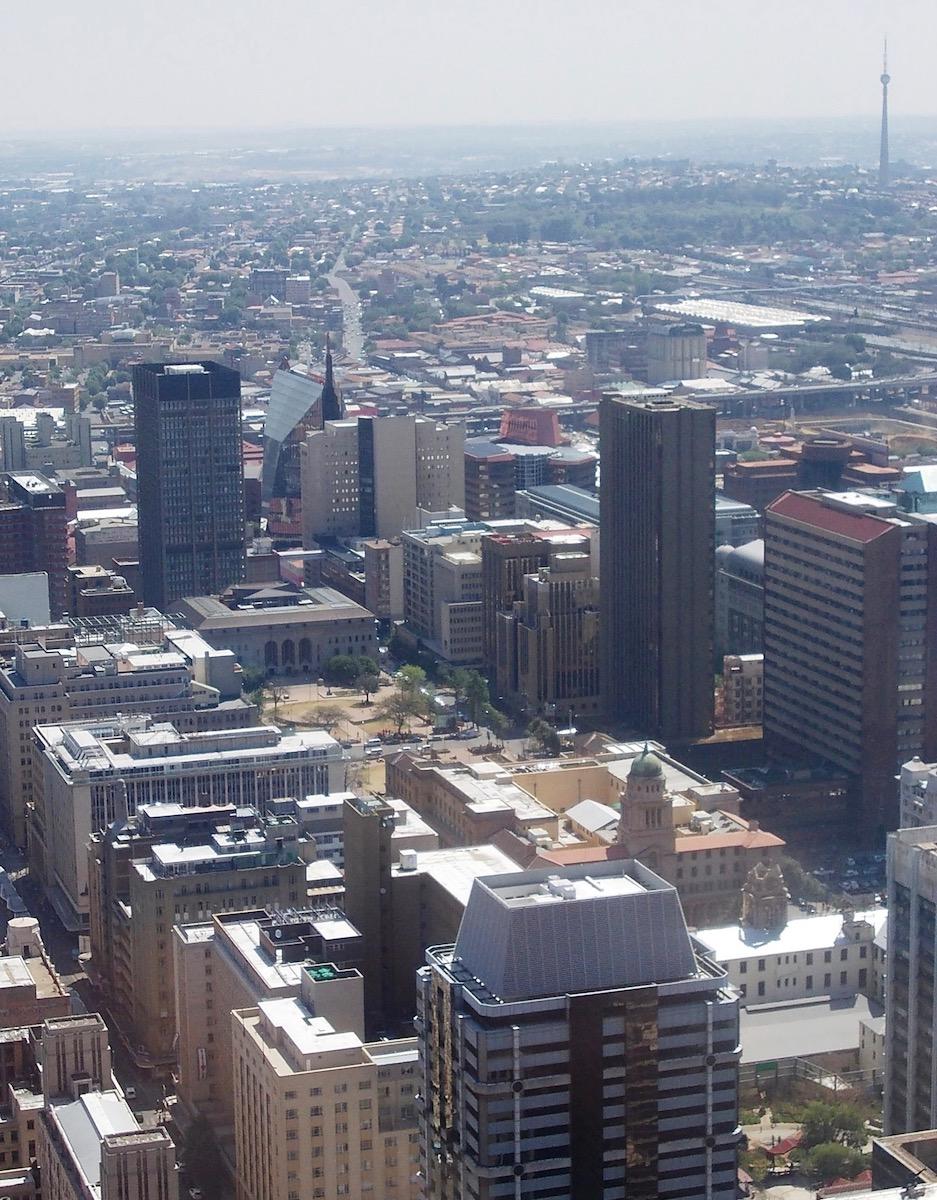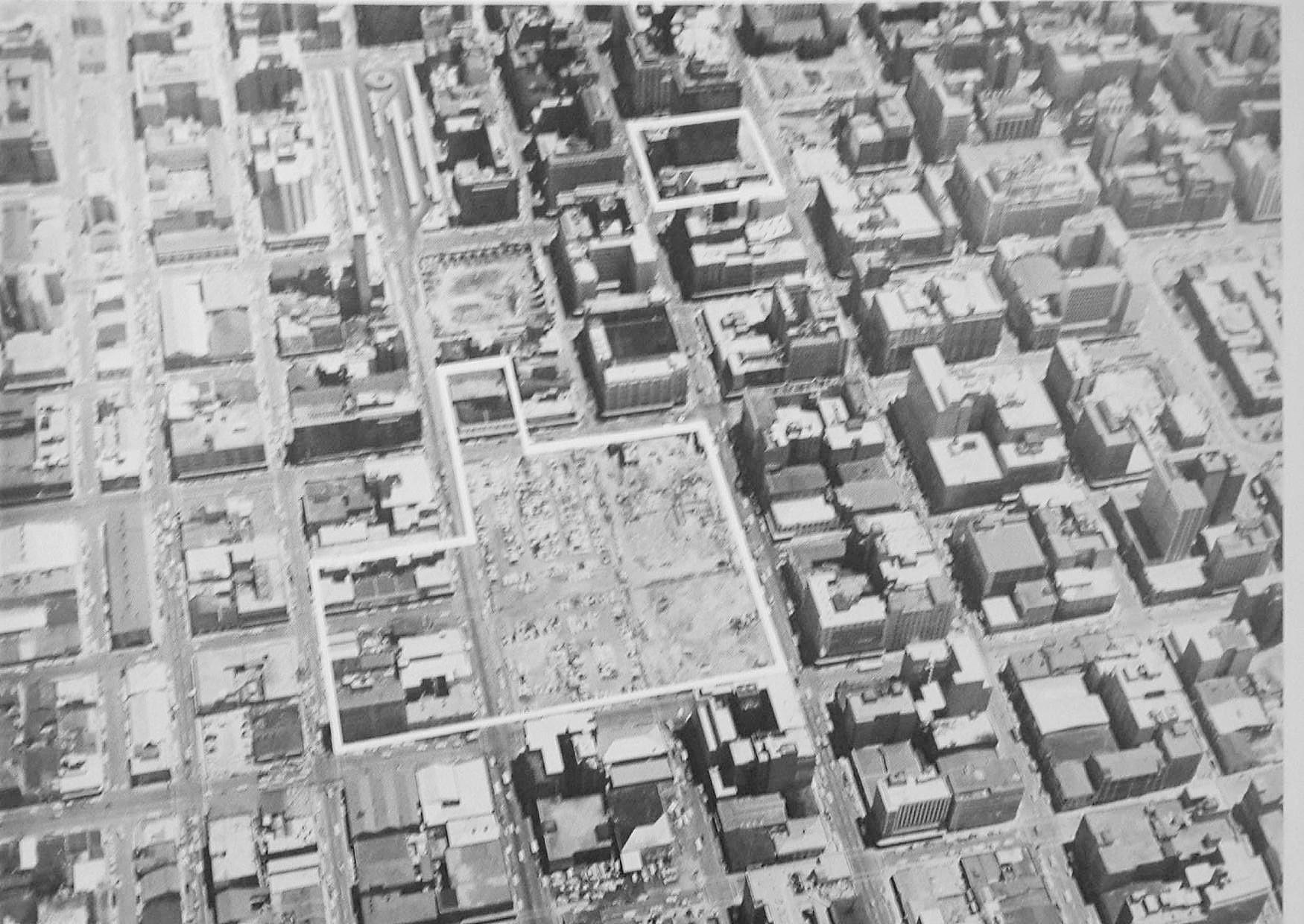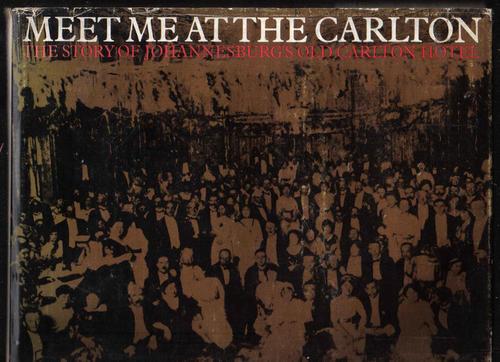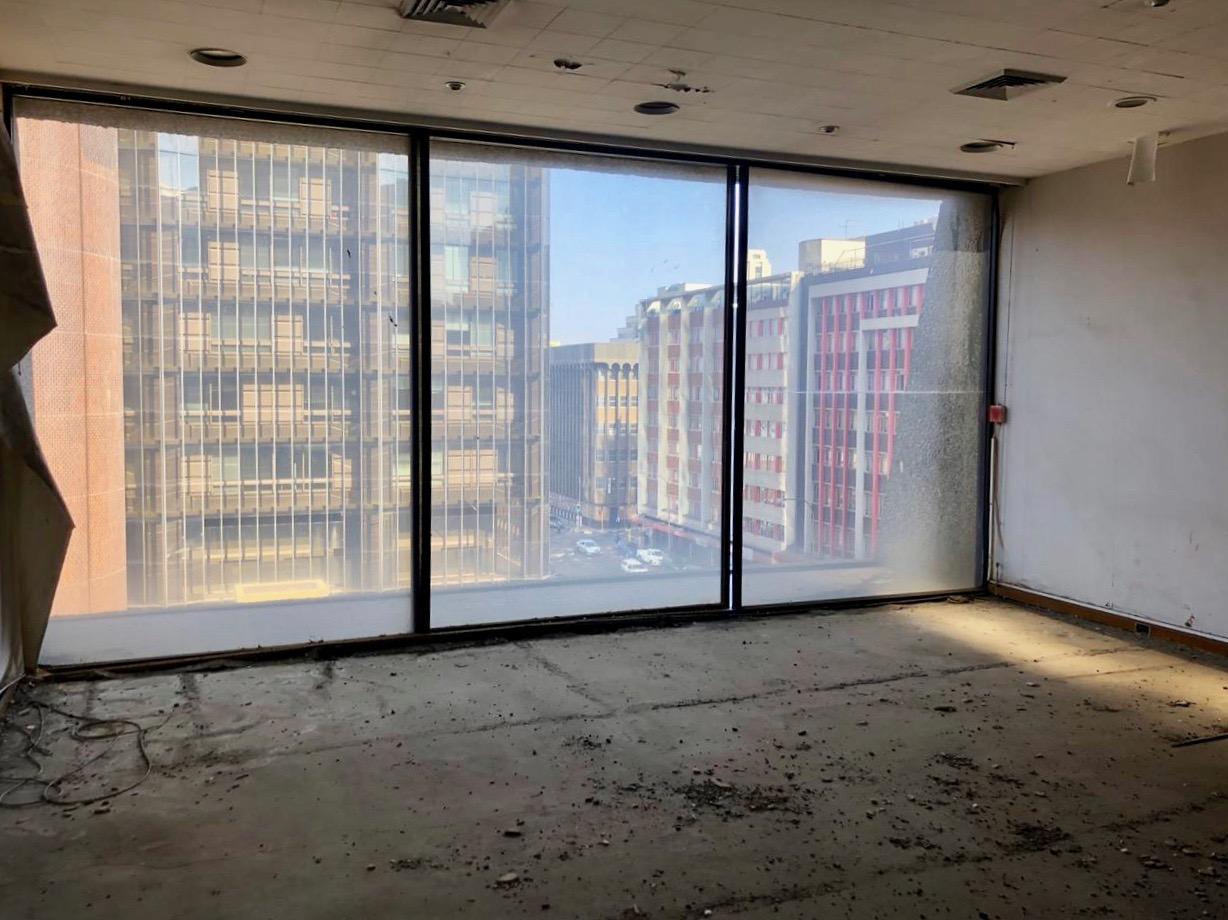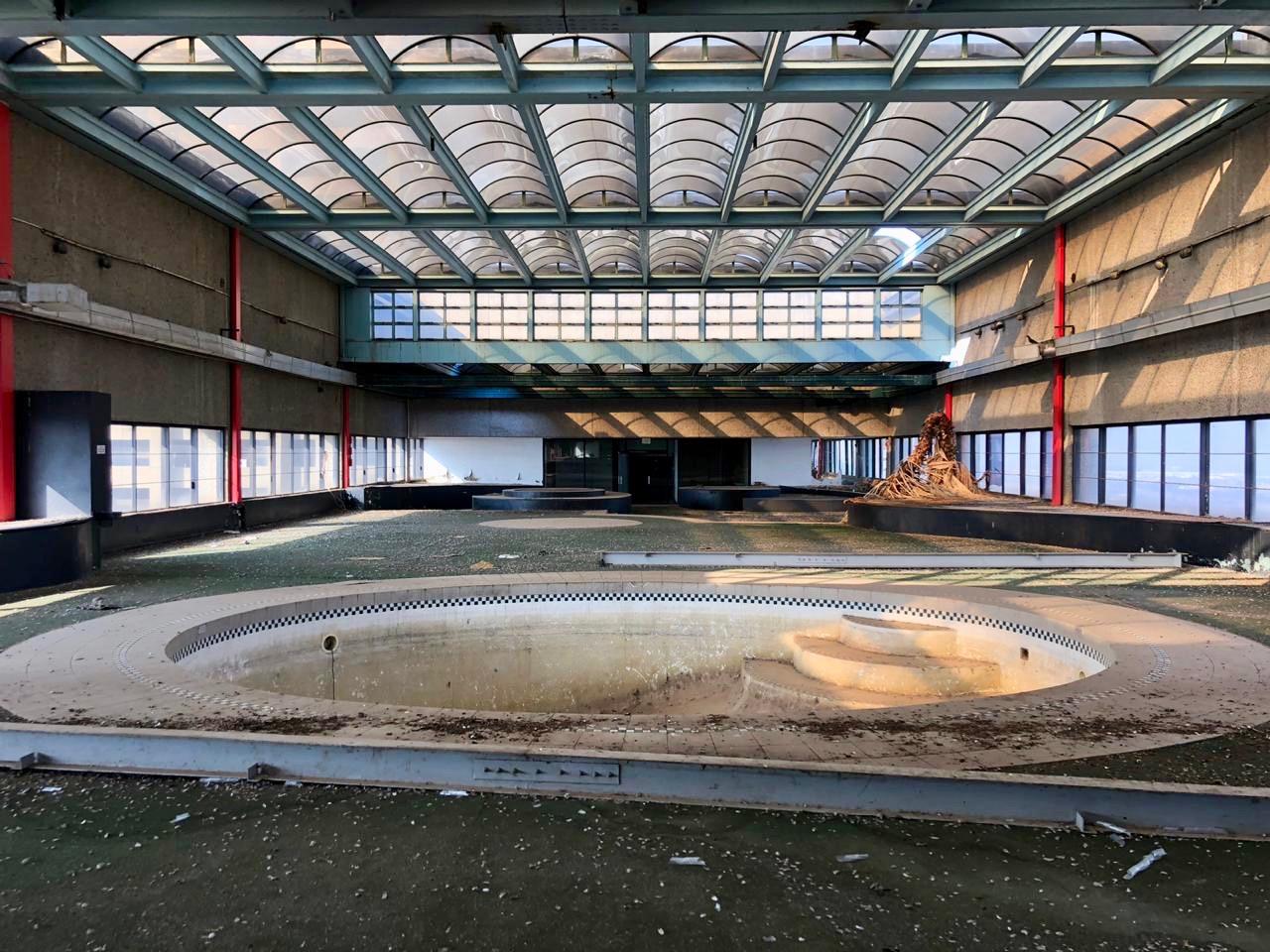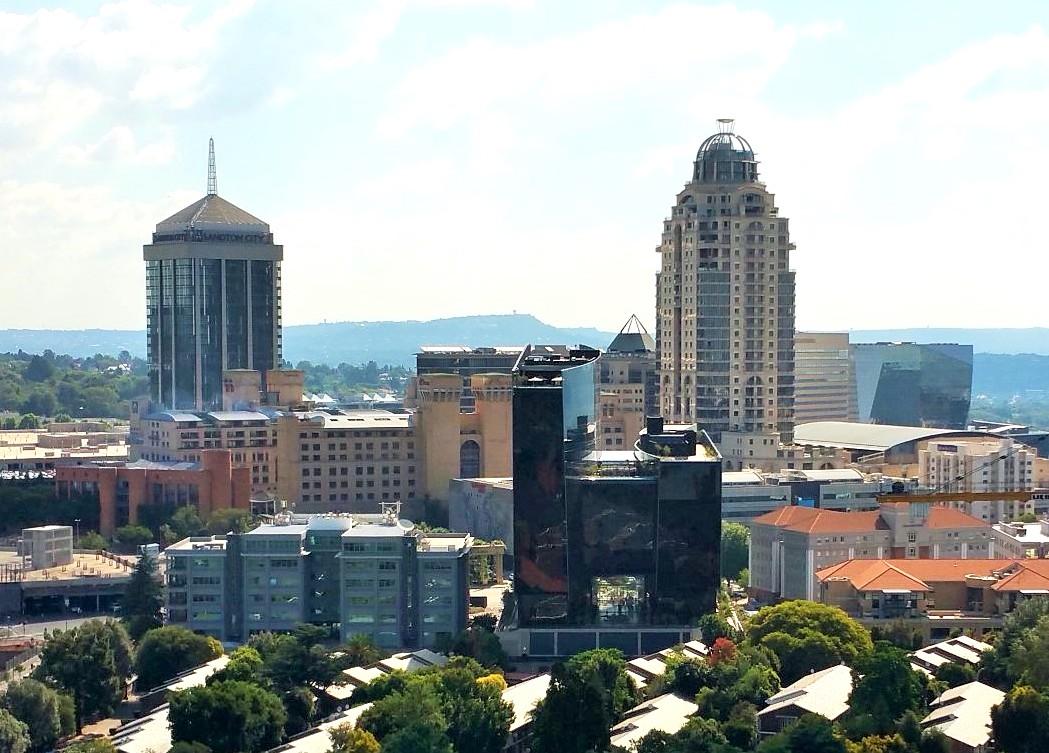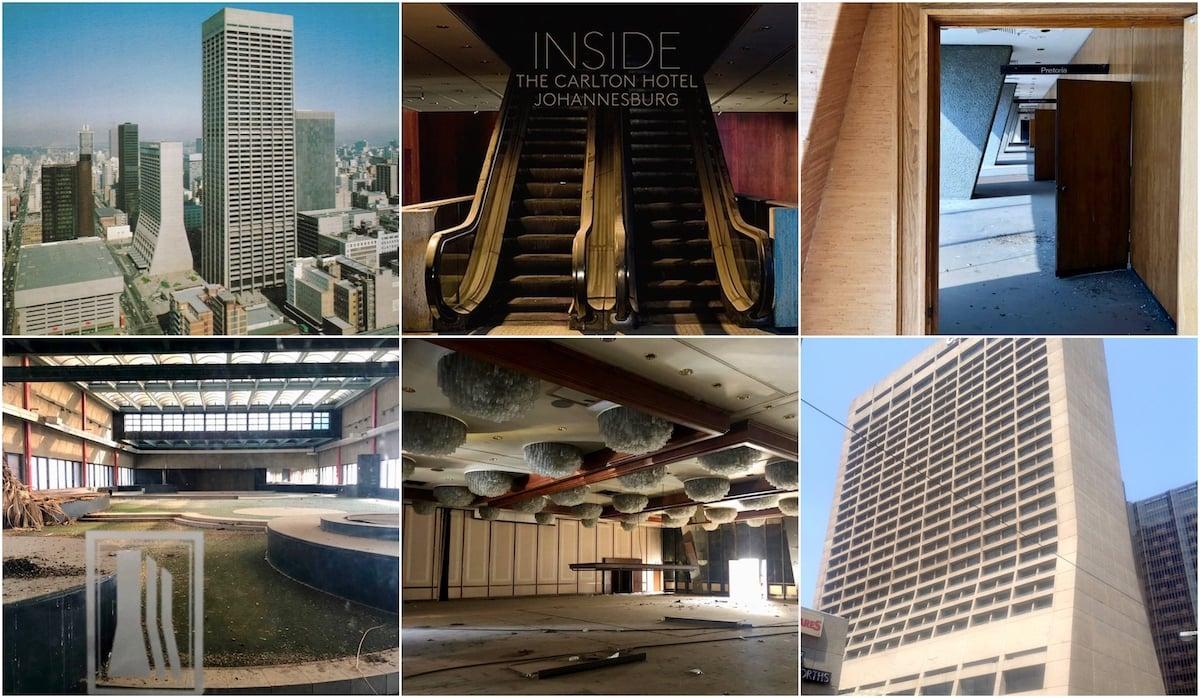
This is a lush plush book on the Carlton Hotel circa 2013 but published in 2017. The Carlton is a ghost place, a mothballed hotel and a symbol both of what downtown Johannesburg was and what it has become. The Carlton is also a metaphor for the ultimate in international style, luxury and aspiration in Johannesburg. The Carlton was the place where Johannesburg showed that it could be a world class city in the decades of the seventies and eighties.
Book Cover
Old postcard of the Carlton Centre complex
It is a beautifully produced book: gold leaf pages, hard cover, quality binding, fine paper and substantial in every sense. It is superbly laid out. The book is bilingual (English and German). It was produced and published in Germany, one can only assume that it was aimed at a foreign readership. For South Africans this is not a local book and unobtainable in say Exclusive Books, yet the subject is a Johannesburg hotel that was a city institution for nearly a century. There were two Carlton hotels in Johannesburg, This book is about the second Carlton.
The First Carlton Hotel (Edwardian Souvenir Album of the Transvaal)
I had long wanted to purchase this volume. I was excited at the time of publication and wanted to review it but the book never came my way. It has to be ordered from abroad. Finally with lockdown I decided that this was one book that had to be delivered to my doorstep by courier and forget the expense. It’s a treat worth waiting for but also forced me into some disquieting reflections.
At one level I was not disappointed and the book was well worth the wait. It is a satisfying, handsome book, 136 pages of dozens of photographs of the interior of the great Anglo American developed hotel. It makes an attractive addition to a coffee table. At another level the book is depressing because the subject matter is in a hopeless situation and there is no solution yet; the Carlton Hotel closed years ago and it has never reopened so it has passed into memory and nostalgia.
Inside the abandoned hotel (Brian McKechnie)
If you were young between the seventies and nineties and lived in Johannesburg you are likely to have partied, wined, dined and maybe enjoyed your honeymoon at the Carlton hotel. You could have shopped at the Carlton Centre or taken a high speed lift to the Top of the Carlton for the spectacular views of the city. Or you might have skated at the Carlton Ice Rink. I loved the Carlton in all its dimensions; my Dad worked for AECI in the office block and it was a treat to visit him there. I once met Mr Oppenheimer at a conference at the hotel; there was the occasional dinner at one of the restaurants.
View over the old heart of the city from the Carlton Centre (The Heritage Portal)
My childhood memories actually go back to the first Carlton Hotel and the pleasures of the old fashioned ambience and style of the shops and the palm court. I watched the Carlton Centre being built in the sixties - with the huge craters and canyons for the thousands of tons of concrete foundations piled into the Highveld soil. A super block was created, dozens of older warehouses and a brewery were demolished to clear a mass of land. Johannesburg’s layout of small grid block units disappeared. New York came to Johannesburg with these super skyscrapers designed by the American architectural firm of Skidmore, Owings and Merrill. During the construction phase it was exciting to drive or walk past and pause to watch this wonder rising to the sky. The Carlton Centre and Hotel swung the focal point of the city eastward away from the City Hall and the Rissik Street Post Office. Joburg had a new heart. It was a bold property development but in retrospect the Carlton complex failed as a long term investment and nowhere failed more spectacularly than the Carlton Hotel.
A superblock was created (Meet me at the Carlton)
The new Carlton Hotel opened in 1972 and each guest was presented with the book by Eric Rosenthal, Meet Me at the Carlton. I have reviewed that title (click here to read) and it remains a collector’s item though the price tag is about half of the price of this new book. That book is full of history and is all about the first Carlton Hotel that dated back to the dreams of Barney Barnato and his nephew Solly Joel. It was completed in 1906.
Old Book Cover
In this book history slips sideways. The focus is not on the history of the Carlton hotels. Nor is it on the hotel as it was as a working enterprise. This is a book by newcomers to the city and there is a freshness in novelty and unfamiliarity.
The two photographers, Bennett and Mueller, are a Swiss couple and this is a book on their photographic work. The couple were awarded a three month studio residency in 2013 and came to live in Johannesburg on a scholarship from Artists Exchange Programme of Basel. They do not explain why they chose Johannesburg or why the city chose them. They arrived in Johannesburg at an odd time – a period where many efforts had and were being made by the City, community groups and the private property initiatives to turn round the city after a hollowing out by white flight, rising crime and overwhelming poverty.
The Carlton Hotel opened in 1972 and closed in 1998. I find it fascinating that the subject they should have chosen for their photo study, should have been the abandoned, now near derelict hotel. They arrived too late to experience the Carlton as it was and instead give us the Carlton as it opened up to them.
An abandoned hotel room (Brian McKechnie)
The subject happens to be the Carlton interior in 2013. There was no hotel at that date, just a ghost and a shell. The Carlton Hotel had been closed for 15 years and there was hardly a stick of furniture left.
Little to nothing left (Brian McKechnie)
On arrival in the city, the authors noticed all the many empty downtown buildings including the heavily guarded, but empty Carlton. They had none of the baggage of past history in the city; they had not been through the transition, nor lived on into post transition years. I suppose they could be arriving at a fairy tale kind of cobweb draped, dust encrusted deserted Sleeping Beauty Castle and they want to share a certain mesmerized pleasure and thrill of the discovery of the abandoned and forgotten.
They gained access to the Carlton and equipped with a torch, a tripod and a camera they photographed the many empty spaces of the hotel from the lobby, through the restaurants to the ball room and up onto the pool and sun deck. This book offers 44 of their selection of photographs. The book is actually a depressing book because it is about decay and abandonment; here are images of empty space, dust, dirt, debris and peeling paint signs, such as the wooden standing board – “Due to a staff shortage today, we regret that a number of tables are not in use – We apologise for the inconvenience”. It would have been twenty years since that sign had any meaning.
The Carlton Hotel was Johannesburg’s pride – it was the international five star hotel – film stars, celebrities, politicians, businessmen and honeymooners came to the Carlton. The racial barriers of the era no longer existed when you stepped into the Carlton. You could enjoy a simple koeksister at the Koffie Huis or a gargantuan feast in the Three Ships Restaurant.
A fellow Swiss art historian and ethnologist, Fiona Siegenthaler has contributed a stimulating introductory essay on Johannesburg: from the Gold of Modernism to the Post-Apartheid Present; this pulls together an overview of the making and the shaping of the city drawing on the standard spread of secondary references; here are the contradictions in the city and the shifting sands of racial and now democratic policy thrusts. She makes the crucial point that the rhetoric of Johannesburg as “world class African city“ still grapples with segregation but today discrimination and divisions are based on economics and a huge divide between rich and poor remains.
There is also a geographical divide between old central Johannesburg and the new glitzy Sandton. How ironic that the luxury once found in the Carlton Hotel is still there but it’s at the Michelangelo or the DaVinci hotels in Sandton. There is a new narrative of wealth and international class with those Italian names in a new part of town.
The luxury is now in Sandton (The Heritage Portal)
The book is about the old Carlton but if you live in Johannesburg and think about how and where the past meets the present, it also poses silent questions about a sustainable future for Sandton, a new city in the north as well as South African history in general.
One may go north but there is no escape from the sharp juxtaposing of wealth and poverty, so ever-present in Johannesburg. Ironically the Carlton Hotel closed in 1998 because there was no longer a demand for accommodation for a five star hotel in the centre of the City.
Each of the carefully posed photographs of dust and debris emptiness hints at what once was; on the opposite page is an apposite quotation extracted from a memoir or a newspaper clipping of past times. I like the choice of texts; my favourite author Tim Ecott once worked at the Carlton and a snip of his memoir appears; there are tales of politicians and the making of grand plans for the future by old political hands and avuncular business leaders (PW Botha meets Harry Oppenheimer in 1979). Or there is the story of the murder of the Carlton’s assistant banqueting manager by fellow hotel employees and dumping his body in the linen room. Mandela hosted a cocktail party for Paul Simon ahead of his concert tour of South Africa.
I wonder if the objective was to place emphasis on the art of the photograph and how best to showcase the shock of the visual. The black background to each photo makes for a sombre dark mood. The script in is gold ink. The book is undeniably beautiful as a product of high quality book manufacture. I don’t find photos of old toilets or smashed ceilings and walls beautiful even if the production of the photograph is stunning. I found my own resurfacing nostalgia overlaid with depression. Sadly there are no exterior photographs and hence no context. There is no map locating the Carlton, first or second on the city’s landscape.
A useful chronology of the Carlton Hotel concludes the book, but the information is simply drawn from Wikipedia. I am pleased the book has joined my Johannesburg book collection, but it is a sad oddity on books about the city. Its strength lies in the original photographs. What future is there for this shell of a great hotel – it remains mothballed.
Kathy Munro is an Honorary Associate Professor in the School of Architecture and Planning at the University of the Witwatersrand. She enjoyed a long career as an academic and in management at Wits University. She trained as an economic historian. She is an enthusiastic book person and has built her own somewhat eclectic book collection over 40 years. Her interests cover Africana, Johannesburg history, history, art history, travel, business and banking histories. She researches and writes on historical architecture and heritage matters. She is a member of the Board of the Johannesburg Heritage Foundation and is a docent at the Wits Arts Museum. She is currently working on a couple of projects on Johannesburg architects and is researching South African architects, war cemeteries and memorials. Kathy is a member of the online book community the Library thing and recommends this cataloging website and worldwide network as a book lover's haven.

